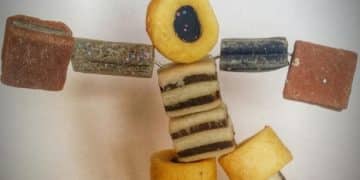Seasonal Toy Scams: How to Avoid Counterfeit and Dangerous Toys Online in the US

Navigating the seasonal toy market can be tricky; learn how to identify and avoid counterfeit and dangerous toys online in the US to ensure a safe and joyful holiday season for your family.
The excitement of the holidays often brings a surge in toy purchases, but it also attracts scammers and counterfeiters. Learn how to protect yourself from seasonal toy scams: How to avoid counterfeit and dangerous toys online in the US, ensuring that the gifts you give are safe and authentic.
The Rise of Seasonal Toy Scams
The holiday season is prime time for toy scams. As demand skyrockets, counterfeiters and unscrupulous sellers flood the market with fake and potentially dangerous products. Understanding this trend is the first step in protecting yourself.
These scams aren’t just about getting a lower-quality toy; they can pose serious health and safety risks to children. From toxic materials to poorly constructed parts, counterfeit toys can be hazardous.
Why Seasonal Peaks Increase Scams
The increase in online shopping and the pressure to find the perfect gift contribute to the rise in scams. Consumers are often in a hurry and may not thoroughly vet sellers or products, making them vulnerable to fraud.
Additionally, limited availability of popular toys can drive buyers to less reputable sources, where counterfeit goods are more likely to be found.
Common Types of Toy Scams
Understanding the various types of scams can help you identify and avoid them. Here are a few common tactics used by counterfeiters:
- Fake Websites: Websites that mimic legitimate retailers to steal your payment information.
- Counterfeit Products: Toys that look similar to genuine ones but are made with substandard materials.
- Price Gouging: Charging exorbitant prices for popular toys that are in high demand.
- Bait-and-Switch: Advertising one product but sending a cheaper or fake alternative.
Staying informed about these tactics can make a significant difference in avoiding scams and ensuring a safe shopping experience.

Identifying Counterfeit Toys
Knowing what to look for can help you spot counterfeit toys before they end up in your cart. Pay attention to the details.
Examining the packaging, labels, and overall quality of the toy can provide valuable clues about its authenticity. Counterfeiters often cut corners, resulting in noticeable flaws.
Packaging and Labeling Clues
Genuine toys typically come in high-quality packaging with clear, professional labeling. Look for these indicators:
- Misspellings: Check for any spelling or grammatical errors on the packaging.
- Poor Print Quality: Fuzzy or low-resolution printing can be a sign of a fake.
- Missing Information: Authentic toys include manufacturer details, safety warnings, and age recommendations.
- Incorrect Logos: Counterfeiters may use slightly altered logos to deceive consumers.
Material and Construction
The quality of materials and construction can also reveal whether a toy is genuine. Inspect the following:
- Cheap Materials: Counterfeit toys often use low-grade plastics, fabrics, or paints.
- Poor Stitching: Look for uneven or loose stitching on plush toys.
- Sharp Edges: Check for any sharp edges or small parts that could be a choking hazard.
- Unusual Smells: A strong chemical odor can indicate the use of toxic materials.
By being vigilant and paying attention to these details, you can significantly reduce your risk of purchasing a counterfeit toy.

Shopping Safely Online
Online shopping offers convenience, but it also presents risks. Follow these tips to shop safely for toys online and avoid scams.
Choosing reputable retailers, reading customer reviews, and using secure payment methods can help protect you from fraud and ensure a positive shopping experience.
Choosing Reputable Retailers
Stick to well-known and trusted retailers when buying toys online. These companies have established reputations and are more likely to sell genuine products.
Avoid purchasing from unknown or unverified websites, especially those offering prices that seem too good to be true.
Reading Customer Reviews
Customer reviews can provide valuable insights into the quality and authenticity of a product. Pay attention to:
- Overall Rating: Look for products with consistently high ratings.
- Detailed Feedback: Read detailed reviews that discuss the product’s quality, durability, and safety.
- Verified Purchases: Check if the reviews are from verified purchasers to ensure they are genuine.
Secure Payment Methods
Protect your financial information by using secure payment methods. Look for these options:
- Credit Cards: Credit cards offer fraud protection and allow you to dispute unauthorized charges.
- PayPal: PayPal provides an added layer of security by keeping your financial information private.
- Secure Websites: Ensure the website uses HTTPS encryption, indicated by a padlock icon in the address bar.
By following these guidelines, you can minimize your risk of encountering scams and enjoy a safer online shopping experience.
Understanding Age Recommendations and Safety Standards
Age recommendations and safety standards are crucial for ensuring that toys are appropriate and safe for children. Familiarize yourself with these guidelines.
Compliance with safety standards and adherence to age recommendations can help prevent accidents and ensure that children are playing with toys that are suitable for their developmental stage.
Age Recommendations
Age recommendations are designed to help you choose toys that are developmentally appropriate and safe for children of different ages.
These recommendations consider factors such as fine motor skills, cognitive abilities, and potential safety hazards like small parts.
Always heed the manufacturer’s age recommendations and choose toys that are suitable for your child’s age and abilities.
Safety Standards and Certifications
Many countries have established safety standards and certifications for toys. Look for these marks to ensure that the toy has been tested and meets certain safety requirements.
- ASTM International: A globally recognized standards organization that develops safety standards for toys.
- EN 71: A European Union standard that specifies safety requirements for toys.
- Consumer Product Safety Commission (CPSC): The US agency responsible for ensuring the safety of consumer products, including toys.
Purchasing toys that meet these standards can provide added assurance of their safety and quality.
Being aware of age recommendations and safety standards can significantly reduce the risk of accidents and ensure that children are playing with toys that are appropriate and safe.
Reporting Suspicious Activity
If you encounter a potential toy scam, reporting it can help protect others and prevent further fraud. Know how and where to report suspicious activity.
Reporting suspicious activity not only helps protect other consumers but also supports efforts to crack down on counterfeiters and scammers.
Identifying Suspicious Activity
Recognize the signs of a potential toy scam. These may include:
- Unusually Low Prices: Prices that are significantly lower than those offered by reputable retailers.
- Lack of Contact Information: A website or seller that does not provide complete contact information.
- Pressure Tactics: High-pressure sales tactics or threats of limited availability.
- Requests for Unusual Payment Methods: Demands for payment via wire transfer or other non-traditional methods.
Where to Report Scams
If you suspect a toy scam, report it to the appropriate authorities. Here are some resources:
- Federal Trade Commission (FTC): Report scams and fraud to the FTC’s online reporting tool.
- Better Business Bureau (BBB): File a complaint with the BBB to report unethical business practices.
- Consumer Product Safety Commission (CPSC): Report unsafe products or injuries caused by toys to the CPSC.
The Importance of Reporting
Reporting suspicious activity can help prevent others from falling victim to scams. It also provides valuable information to law enforcement agencies and consumer protection organizations.
By taking the time to report potential scams, you can play a role in protecting consumers and ensuring a safer marketplace for toys.
Reporting suspicious activity is a crucial step in combating toy scams and protecting consumers from fraud.
Staying Updated on Toy Safety Recalls
Toy safety recalls are an important tool for removing dangerous products from the market. Stay informed about recalls and know how to check if a toy has been recalled.
Staying informed about toy safety recalls can help protect children from potentially dangerous products and prevent accidents.
How to Find Recall Information
Several resources provide information about toy safety recalls. Check these sources regularly:
- Consumer Product Safety Commission (CPSC): The CPSC website lists all recalls of consumer products, including toys.
- Manufacturer Websites: Many toy manufacturers have recall information on their websites.
- News Outlets: Major news outlets often report on significant toy safety recalls.
What to Do if a Toy is Recalled
If you own a toy that has been recalled, take the following steps:
- Stop Using the Toy: Immediately stop using the toy and keep it away from children.
- Contact the Manufacturer: Contact the manufacturer to find out how to receive a refund, replacement, or repair.
- Follow Instructions: Follow the manufacturer’s instructions for returning or disposing of the toy.
By staying informed about toy safety recalls and taking prompt action when necessary, you can help protect children from potentially dangerous products.
| Key Point | Brief Description |
|---|---|
| 🔍 Identifying Fakes | Check packaging, materials, and labels for signs of counterfeiting. |
| 🛡️ Safe Shopping | Buy from reputable retailers and use secure payment methods. |
| ⚠️ Reporting Scams | Report suspicious activities to the FTC and BBB. |
| 🚨 Recall Awareness | Stay informed on toy recalls from the CPSC and manufacturers. |
Frequently Asked Questions
▼
Common signs include poor packaging, misspellings, low-quality materials, and missing safety labels. Always compare the toy to official product images online.
▼
Look for established retailers with secure websites (HTTPS), transparent contact information, and positive customer reviews. Avoid unknown or unverified sellers.
▼
Stop using the toy immediately. Contact the seller and request a refund. Report the incident to the FTC and CPSC to protect other consumers.
▼
Check the CPSC website regularly for the latest toy safety recalls. You can also find recall information on the manufacturer’s website and major news outlets.
▼
Age recommendations ensure that toys are developmentally appropriate and safe for children. They consider factors like small parts and cognitive abilities to prevent accidents.
Conclusion
By staying informed about the risks of seasonal toy scams: How to avoid counterfeit and dangerous toys online in the US, you can protect your family and ensure a safe and joyful holiday season. Always prioritize safety and authenticity when purchasing toys online.





